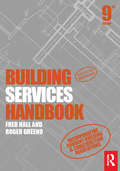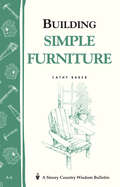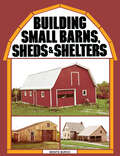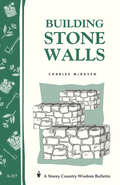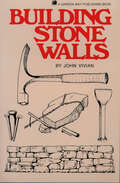- Table View
- List View
Building Services Handbook: Incorporating Current Building And Construction Regulations - Xplana Bundle
by Fred Hall Roger GreenoThe ninth edition of Hall and Greeno's leading textbook has been reviewed and updated in relation to the latest building and water regulations, new technology, and new legislation. For this edition, new updates includes: the reappraisal of CO2 emissions targets, updates to sections on ventilation, fuel, A/C, refrigeration, water supply, electricity and power supply, sprinkler systems, and much more. Building Services Handbook summarises the application of all common elements of building services practice, technique and procedure, to provide an essential information resource for students as well as practitioners working in building services, building management and the facilities administration and maintenance sectors of the construction industry. Information is presented in the highly illustrated and accessible style of the best-selling companion title Building Construction Handbook. THE comprehensive reference for all construction and building services students, Building Services Handbook is ideal for a wide range of courses including NVQ and BTEC National through Higher National Certificate and Diploma to Foundation and three-year Degree level. The clear illustrations and complementary references to industry Standards combine essential guidance with a resource base for further reading and development of specific topics.
Building Services Handbook
by Fred Hall Roger GreenoThe tenth edition of Hall and Greeno's leading textbook has been reviewed and updated in relation to the latest building, wiring and water regulations, new technology and new legislation. For this edition, new updates include electric vehicle charging, overheating in buildings, waste water treatment, energy performance certification, mechanical ventilation, food waste recycling, electro-magnetic lifts, biogas processing and much more. Building Services Handbook summarises the application of all common elements of building services practice, technique and procedure to provide an essential information resource for students as well as practitioners working in building services, building management and the facilities administration and maintenance sectors of the construction industry. Information is presented in a highly illustrated and accessible style. The comprehensive reference for all construction and building services students, Building Services Handbook is ideal for a wide range of courses including T Level, NVQ and BTEC National through Higher National Certificate and Diploma to Foundation and three-year Degree level. The clear illustrations and complementary references to industry Standards combine essential guidance with a resource base for further reading and development of specific topics.
Building Services Handbook
by Fred Hall Roger GreenoThe tenth edition of Hall and Greeno's leading textbook has been reviewed and updated in relation to the latest building, wiring and water regulations, new technology and new legislation. For this edition, new updates include electric vehicle charging, overheating in buildings, waste water treatment, energy performance certification, mechanical ventilation, food waste recycling, electro-magnetic lifts, biogas processing and much more. Building Services Handbook summarises the application of all common elements of building services practice, technique and procedure to provide an essential information resource for students as well as practitioners working in building services, building management and the facilities administration and maintenance sectors of the construction industry. Information is presented in a highly illustrated and accessible style. The comprehensive reference for all construction and building services students, Building Services Handbook is ideal for a wide range of courses including T Level, NVQ and BTEC National through Higher National Certificate and Diploma to Foundation and three-year Degree level. The clear illustrations and complementary references to industry Standards combine essential guidance with a resource base for further reading and development of specific topics.
Building Services Procurement
by Christopher MarshProcurers and contractors increasingly need practical guidance for the strategic procurement of building services. Clients seeking to improve the delivery performance of the construction industry are increasingly using alternative procurement arrangements. These modern arrangements attempt to deliver a more strategic approach to achieving value for money. Yet little thought is ever given to the strategic importance of building services. No other single aspect of a project will affect project success more than the timely delivery of a fully functioning services installation. Beyond the normal considerations of time, cost and quality, building services have a series of unique requirements not normally considered. For the first time these unique requirements are combined in a single text, providing the reader with the definitive guide to building services procurement. The text reviews each of the major critical success factors and clearly explains the supporting processes that must be enacted to ensure success. It reviews the general nature of procurement systems and construction projects, and then explores the increasing importance that building services play both in the construction process and in determining success for the client. Each significant stage within the procurement process is explored by explaining its importance and showing what decisions need to be made to develop a cohesive strategy. It concludes by giving a step-by-step guide to clearly develop and implement a building services procurement strategy.
Building Services Procurement
by Christopher MarshProcurers and contractors increasingly need practical guidance for the strategic procurement of building services. Clients seeking to improve the delivery performance of the construction industry are increasingly using alternative procurement arrangements. These modern arrangements attempt to deliver a more strategic approach to achieving value for money. Yet little thought is ever given to the strategic importance of building services. No other single aspect of a project will affect project success more than the timely delivery of a fully functioning services installation. Beyond the normal considerations of time, cost and quality, building services have a series of unique requirements not normally considered. For the first time these unique requirements are combined in a single text, providing the reader with the definitive guide to building services procurement. The text reviews each of the major critical success factors and clearly explains the supporting processes that must be enacted to ensure success. It reviews the general nature of procurement systems and construction projects, and then explores the increasing importance that building services play both in the construction process and in determining success for the client. Each significant stage within the procurement process is explored by explaining its importance and showing what decisions need to be made to develop a cohesive strategy. It concludes by giving a step-by-step guide to clearly develop and implement a building services procurement strategy.
Building Services, Technology and Design
by Roger GreenoBuilding Services, Technology and Design provides a concise guide to the installation and design of principal services in domestic and commercial buildings. It covers the level 2 module of The CIOB's Education Framework and is officially sanctioned by the CIOB as the recognised text for that module. The book combines theory, design and application in one volume and is supported throughout with illustrations, design examples, tables and charts.Services covered include: cold and hot water; heating; ventilation; air conditioning; gas; electricity; security; fire control; sanitation; drainage and transport systems.Building Services, Technology and Design is a core text for the CIOB level 2 module, as well as BTEC HNC/D building studies and degree courses in building. It is also an essential reference for all members of the facilities management and construction industry.
Building Services, Technology and Design
by Roger GreenoBuilding Services, Technology and Design provides a concise guide to the installation and design of principal services in domestic and commercial buildings. It covers the level 2 module of The CIOB's Education Framework and is officially sanctioned by the CIOB as the recognised text for that module. The book combines theory, design and application in one volume and is supported throughout with illustrations, design examples, tables and charts.Services covered include: cold and hot water; heating; ventilation; air conditioning; gas; electricity; security; fire control; sanitation; drainage and transport systems.Building Services, Technology and Design is a core text for the CIOB level 2 module, as well as BTEC HNC/D building studies and degree courses in building. It is also an essential reference for all members of the facilities management and construction industry.
Building Shanghai: The Story of China's Gateway
by Edward Denison Guang Yu RenShanghai's illustrious history and phenomenal future is celebrated in this book, which examines the evolution of the city's architecture and urban form in order to contextualise the challenges facing the city today. The physical legacies that reflect Shanghai's uniqueness historically and contemporarily are examined chronologically using specific case studies of exemplary architecture interwoven in a compelling narrative that unlocks the many mysteries surrounding this amazing metropolis. Some of the most influential colonial architecture in the world, outstanding examples of Modernism and Art Deco, and an exceptional selection of eclectic and vernacular architecture reflecting Shanghai's many adopted cultures are revealed. This is the first book ever to examine this remarkable subject in a manner that is both comprehensive and captivating in its written content and stunningly illustrated with over 300 archive and contemporary photographs and maps.
Building Shanghai: The Story of China's Gateway
by Edward Denison Guang Yu RenShanghai's illustrious history and phenomenal future is celebrated in this book, which examines the evolution of the city's architecture and urban form in order to contextualise the challenges facing the city today. The physical legacies that reflect Shanghai's uniqueness historically and contemporarily are examined chronologically using specific case studies of exemplary architecture interwoven in a compelling narrative that unlocks the many mysteries surrounding this amazing metropolis. Some of the most influential colonial architecture in the world, outstanding examples of Modernism and Art Deco, and an exceptional selection of eclectic and vernacular architecture reflecting Shanghai's many adopted cultures are revealed. This is the first book ever to examine this remarkable subject in a manner that is both comprehensive and captivating in its written content and stunningly illustrated with over 300 archive and contemporary photographs and maps.
Building Simple Furniture: Storey Country Wisdom Bulletin A-06 (Storey Country Wisdom Bulletin)
by Cathy BakerEASY-TO-BUILD PROJECTS FOR THE WEEKEND WOODWORKER!Look over the variety of simple wood-working projects in the bulletin and you’ll quickly find something that deserves a place in your home. A small table for the hallway, perhaps, or an Adirondack chair or picnic set for the deck or garden? The good news is that you don’t need to be a master carpenter with a basement full of power tools to craft these handsome and practical items. With a few simple hand tools and Cathy Baker’s step-by-step instructions and easy-to-follow illustrations and diagrams, you can build sturdy, durable, beautiful wooden furniture that you and your family will enjoy for years to come. Projects include:· Wall shelf· Small bench· Picnic table and benches· Adirondack chair· Pump lamp· Step stool· Storage box· Side table
Building Small Barns, Sheds & Shelters
by Monte BurchBuild your own outbuildings and enjoy the space to do more of what you love. From simple toolsheds and animal shelters to smokehouses and low-cost barns, Monte Burch guides you through everything you need to know to make your small building projects a reality. Detailed blueprints, easy-to-follow instructions, and expert advice are suited to even the first-time builder. Discover how easy it is to create your own customized spaces that will allow your passions to grow.
Building Socialism: Architecture and Urbanism in East German Literature, 1955-1973 (New Directions in German Studies)
by Curtis SwopeBuilding Socialism reveals how East German writers' engagement with the rapidly changing built environment from the mid-1950s to the early 1970s constitutes an untold story about the emergence of literary experimentation in the post-War period. It breaks new ground by exploring the centrality of architecture to a mid-century modernist literature in dialogue with multiple literary and left-wing theoretical traditions and in tune with international assessments of modernist architecture and urban planning. Design and construction were a central part of politics and everyday life in East Germany during this time as buildings old and new were asked to bear heavy ideological and social burdens. In their novels, stories, and plays, Heiner Müller, Christa Wolf, Günter Kunert, Volker Braun, Günter de Bruyn, and Brigitte Reimann responded to enormous new factory complexes, experimental new towns, the demolition of Berlin's tenements, and the propagation of a pared-down modernist aesthetic in interior design. Writers' representation of the design, construction, and use of architecture formed part of a turn to modernist literary devices, including montage, metaphor, and shifting narrative perspectives. East Germany's literary architecture also represents a sophisticated theoretical reflection on the intractable problems of East Germany's socialist modernity, including the alliance between state socialism and technological modernization, competing commitments to working-class self-organization and the power of specialist planners and designers, and the attempt to create an alternative to fascism.
Building Socialism: Architecture And Urbanism In East German Literature, 1955-1973 (New Directions In German Studies #19)
by Dr Curtis SwopeBuilding Socialism reveals how East German writers' engagement with the rapidly changing built environment from the mid-1950s to the early 1970s constitutes an untold story about the emergence of literary experimentation in the post-War period. It breaks new ground by exploring the centrality of architecture to a mid-century modernist literature in dialogue with multiple literary and left-wing theoretical traditions and in tune with international assessments of modernist architecture and urban planning. Design and construction were a central part of politics and everyday life in East Germany during this time as buildings old and new were asked to bear heavy ideological and social burdens. In their novels, stories, and plays, Heiner Müller, Christa Wolf, Günter Kunert, Volker Braun, Günter de Bruyn, and Brigitte Reimann responded to enormous new factory complexes, experimental new towns, the demolition of Berlin's tenements, and the propagation of a pared-down modernist aesthetic in interior design. Writers' representation of the design, construction, and use of architecture formed part of a turn to modernist literary devices, including montage, metaphor, and shifting narrative perspectives. East Germany's literary architecture also represents a sophisticated theoretical reflection on the intractable problems of East Germany's socialist modernity, including the alliance between state socialism and technological modernization, competing commitments to working-class self-organization and the power of specialist planners and designers, and the attempt to create an alternative to fascism.
Building Stone Walls: Storey's Country Wisdom Bulletin A-217 (Storey Country Wisdom Bulletin)
by Charles McRavenSince 1973, Storey's Country Wisdom Bulletins have offered practical, hands-on instructions designed to help readers master dozens of country living skills quickly and easily. There are now more than 170 titles in this series, and their remarkable popularity reflects the common desire of country and city dwellers alike to cultivate personal independence in everyday life.
Building Stone Walls
by John VivianRustic and charming or stately and proud, a well-built stone wall can add personality and beauty to your property. John Vivian&’s lively approach and step-by-step instructions encourage you to transform a pile of rocks into an enduring landscape feature with gates, retaining walls, or stiles to suit your needs. Whatever unique challenges come with your site — poor drainage, sloping ground, or low-quality rubble material — Vivian offers innovative designs and reproducible methods to help you build a beautiful, long-lasting wall.
Building Structures: understanding the basics
by Malcolm MillaisThis is a one-stop book for knowing everything important about building structures. Self-contained and with no prerequisites needed, it is suitable for both general readers and building professionals. follow the history of structural understanding; grasp the concepts of structural behaviour via step-by-step explanations; apply these concepts to a simple building; see how these concepts apply to real buildings, from Durham Cathedral to the Bank of China; use these concepts to define the design process; see how these concepts inform design choices; understand how engineering and architecture have diverged, and what effect this had; learn to do simple but relevant numerical calculations for actual structures; understand when dynamics are important; follow the development of progressive collapse prevention; enter the world of modern structural theory; see how computers can be used for structural analysis; learn how to organise and design a successful project. With more than 500 pages and over 1100 user-friendly diagrams, this book is a must for anyone who would like to understand the fascinating world of structures.
Building Structures: understanding the basics
by Malcolm MillaisThis is a one-stop book for knowing everything important about building structures. Self-contained and with no prerequisites needed, it is suitable for both general readers and building professionals. follow the history of structural understanding; grasp the concepts of structural behaviour via step-by-step explanations; apply these concepts to a simple building; see how these concepts apply to real buildings, from Durham Cathedral to the Bank of China; use these concepts to define the design process; see how these concepts inform design choices; understand how engineering and architecture have diverged, and what effect this had; learn to do simple but relevant numerical calculations for actual structures; understand when dynamics are important; follow the development of progressive collapse prevention; enter the world of modern structural theory; see how computers can be used for structural analysis; learn how to organise and design a successful project. With more than 500 pages and over 1100 user-friendly diagrams, this book is a must for anyone who would like to understand the fascinating world of structures.
Building Structures Illustrated: Patterns, Systems, and Design
by Francis D. Ching Barry S. Onouye Douglas ZuberbuhlerA new edition of Francis D.K. Ching's illustrated guide to structural design Structures are an essential element of the building process, yet one of the most difficult concepts for architects to grasp. While structural engineers do the detailed consulting work for a project, architects should have enough knowledge of structural theory and analysis to design a building. Building Structures Illustrated takes a new approach to structural design, showing how structural systems of a building—such as an integrated assembly of elements with pattern, proportions, and scale—are related to the fundamental aspects of architectural design. The book features a one-stop guide to structural design in practice, a thorough treatment of structural design as part of the entire building process, and an overview of the historical development of architectural materails and structure. Illustrated throughout with Ching's signature line drawings, this new Second Edition is an ideal guide to structures for designers, builders, and students. Updated to include new information on building code compliance, additional learning resources, and a new glossary of terms Offers thorough coverage of formal and spatial composition, program fit, coordination with other building systems, code compliance, and much more Beautifully illustrated by the renowned Francis D.K. Ching Building Structures Illustrated, Second Edition is the ideal resource for students and professionals who want to make informed decisions on architectural design.
Building Structures Illustrated: Patterns, Systems, and Design
by Francis D. Ching Barry S. Onouye Douglas ZuberbuhlerA new edition of Francis D.K. Ching's illustrated guide to structural design Structures are an essential element of the building process, yet one of the most difficult concepts for architects to grasp. While structural engineers do the detailed consulting work for a project, architects should have enough knowledge of structural theory and analysis to design a building. Building Structures Illustrated takes a new approach to structural design, showing how structural systems of a building—such as an integrated assembly of elements with pattern, proportions, and scale—are related to the fundamental aspects of architectural design. The book features a one-stop guide to structural design in practice, a thorough treatment of structural design as part of the entire building process, and an overview of the historical development of architectural materails and structure. Illustrated throughout with Ching's signature line drawings, this new Second Edition is an ideal guide to structures for designers, builders, and students. Updated to include new information on building code compliance, additional learning resources, and a new glossary of terms Offers thorough coverage of formal and spatial composition, program fit, coordination with other building systems, code compliance, and much more Beautifully illustrated by the renowned Francis D.K. Ching Building Structures Illustrated, Second Edition is the ideal resource for students and professionals who want to make informed decisions on architectural design.
Building Surveyor’s Pocket Book (Routledge Pocket Books)
by Melanie Smith Christopher GorseBuilding Surveyor’s Pocket Book is an accessible encyclopaedia of matters vital to building surveyors. Well-illustrated with diagrams, pictures, tables, and graphs, it covers all essential elements of building pathology, building performance, and building construction terminology in a simple, accessible way for the practitioner and student. This Pocket Book provides a practical and portable reference text, working as a first-stop publication for those wishing to refresh their knowledge or in need of guidance on surveying practice. Working through fundamental principles in key practice areas, the book is not overly bound by the regulation and legislation of one region, and the principles can be applied internationally. This book is ideal reading for individual surveyors, practitioners, and students in building surveying, facilities management, refurbishment, maintenance, renovation, and services management. It is also of use for those interested in building forensics, building performance, pathology, and anyone studying for their RICS APC. Many other professions in architecture, contracting, engineering, and safety will also find the book of use when undertaking similar practice.
Building Surveyor’s Pocket Book (Routledge Pocket Books)
by Melanie Smith Christopher GorseBuilding Surveyor’s Pocket Book is an accessible encyclopaedia of matters vital to building surveyors. Well-illustrated with diagrams, pictures, tables, and graphs, it covers all essential elements of building pathology, building performance, and building construction terminology in a simple, accessible way for the practitioner and student. This Pocket Book provides a practical and portable reference text, working as a first-stop publication for those wishing to refresh their knowledge or in need of guidance on surveying practice. Working through fundamental principles in key practice areas, the book is not overly bound by the regulation and legislation of one region, and the principles can be applied internationally. This book is ideal reading for individual surveyors, practitioners, and students in building surveying, facilities management, refurbishment, maintenance, renovation, and services management. It is also of use for those interested in building forensics, building performance, pathology, and anyone studying for their RICS APC. Many other professions in architecture, contracting, engineering, and safety will also find the book of use when undertaking similar practice.
Building Surveys
by Peter GloverBuilding Surveys has been a trusted guide for both students and professionals for nearly 40 years, evolving throughout its nine editions to address the challenges and responsibilities of the building surveying role. It covers everything needed for initial inspections such as equipment, know-how and procedures to writing an accurate report, making it indispensable to those practising in or studying this field. • This updated Ninth Edition features new material on modern methods of construction, new sustainable materials, new surveying technologies and industry developments in the wake of the Grenfell Fire. • Essential reading for building construction students, professional surveyors and others who may be required to inspect and report on buildings. • Illustrated throughout with colour photos showing examples of building defects in full detail. All the structural aspects of property surveying are explained, covering foundations, walls and roofs as well as what to look out for and how to deal with problems. Materials and techniques no longer in use are covered as well as new technologies, so the reader is prepared for anything they might encounter. Legal considerations and recent cases are also used to illustrate good working practice, making this an extremely practical companion to the subject.
Building Surveys
by Peter GloverBuilding Surveys has been a trusted guide for both students and professionals for nearly 40 years, evolving throughout its nine editions to address the challenges and responsibilities of the building surveying role. It covers everything needed for initial inspections such as equipment, know-how and procedures to writing an accurate report, making it indispensable to those practising in or studying this field. • This updated Ninth Edition features new material on modern methods of construction, new sustainable materials, new surveying technologies and industry developments in the wake of the Grenfell Fire. • Essential reading for building construction students, professional surveyors and others who may be required to inspect and report on buildings. • Illustrated throughout with colour photos showing examples of building defects in full detail. All the structural aspects of property surveying are explained, covering foundations, walls and roofs as well as what to look out for and how to deal with problems. Materials and techniques no longer in use are covered as well as new technologies, so the reader is prepared for anything they might encounter. Legal considerations and recent cases are also used to illustrate good working practice, making this an extremely practical companion to the subject.
Building Sustainability in East Asia: Policy, Design and People
by Vincent S. Cheng Jimmy C. TongBuilding Sustainability in East Asia: Policy, Design and People illustrates the holistic approaches and individual strategies to building sustainability that have been implemented in construction projects in Asia. Top-down and bottom-up approaches (from formulating policy to constructing individual buildings) are effective in terms of the sustainable development of cities, and this book covers both, illustrated with a range of case study developments.
Building Sustainability in East Asia: Policy, Design and People
by Vincent S. Cheng Jimmy C. TongBuilding Sustainability in East Asia: Policy, Design and People illustrates the holistic approaches and individual strategies to building sustainability that have been implemented in construction projects in Asia. Top-down and bottom-up approaches (from formulating policy to constructing individual buildings) are effective in terms of the sustainable development of cities, and this book covers both, illustrated with a range of case study developments.
